Naturally, new clients are concerned with the total price of a project. This is normal. With this in mind, there are different strategies to help you build a comprehensive offer.
Most people break down the necessary tasks and estimate how long each task will take. Pretty easy and super accurate, right? Nope! In the beginning of my own freelance experience, I was wrong almost all the time. So, I found a new strategy that made my estimates more accurate.
Multiply your estimate
At the web agency where I once worked as art director, we always underestimated the time in our proposals. The numbers we needed were there because we had proper time tracking in place. We went through finished projects and checked how much longer it took us on average.
We came up with a pricing strategy of hours x 1.6, meaning that it took us an average 1.6 times to complete a project than we expected. From then on, we multiplied the hours we thought it would take to complete a job by 1.6. So, a 100-hour job became a 160-hour job, and so on.
I used that strategy a lot before I came up with something that worked better for my business.
Estimating days, not hours
The simplest solutions are usually the best. Think about a certain task that takes you 1 hour. Do you have something in mind? Take a moment and get really clear on a specific task that takes you an hour to complete. It’s critical to have a certain task in mind to get my point.
Do you think you can do a similar task in a row, 8 times in 8 hours? I know I can’t.
When we estimate in hours, we think about the most productive time slot we have. We don’t think about our average efficiency throughout the day. When you start to estimate tasks in days, you get much more accurate numbers. If something takes less than a day, combine it with something else.
There is an additional benefit to this form of estimation: your client also shifts his mindset away from hours to days.
Sometimes, it’s hard to structure smaller projects in a way that allows you to estimate in days. In this case, try using half-days instead.
Will you implement this strategy the next time you have to estimate a project?

